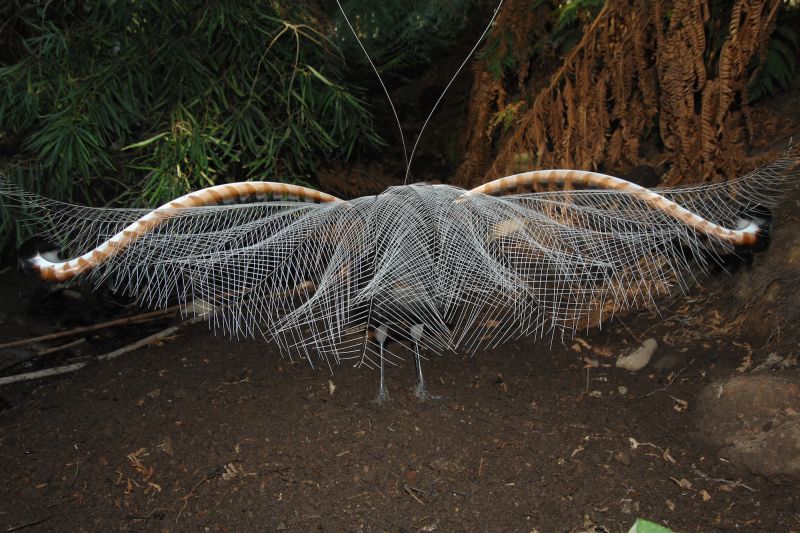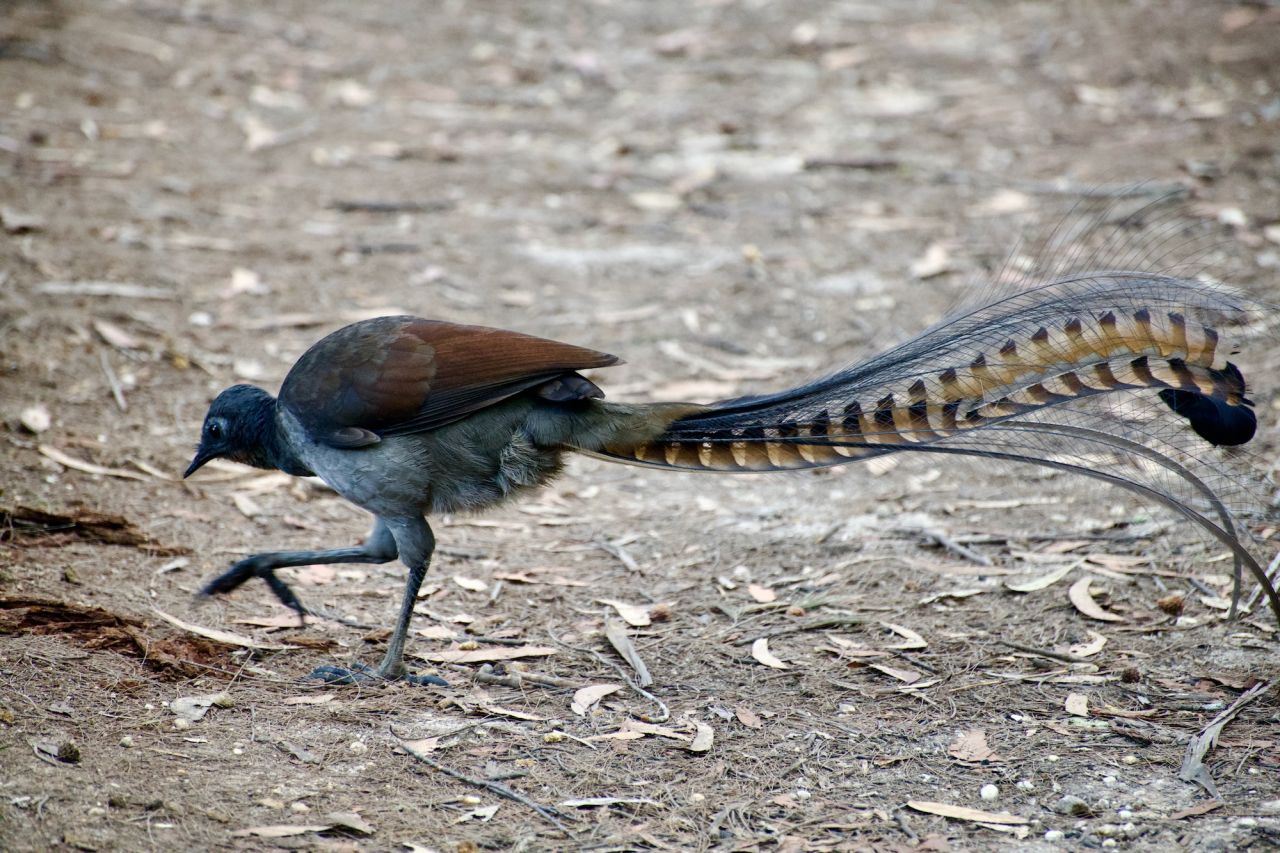The Superb Lyrebird (Menura novaehollandiae) is one of Australia's most fascinating and unique birds. Famous for its extraordinary ability to mimic natural and artificial sounds, this species is a true icon of the country's forests. Often heard before it is seen, the Superb Lyrebird's complex vocal repertoire can include chainsaws, camera shutters, and even other bird species' calls. Found in the dense forests of southeastern Australia, these ground-dwelling birds play a crucial role in their ecosystems by turning over soil and leaf litter while foraging.
What else can lyrebirds mimic?
Superb Lyrebirds are known the mimic the following sounds:
- Car alarms
- Mobile phone ringtones
- Power tools
- Crying babies
- Human voices
Size and appearance
The Superb Lyrebird is a large, ground-dwelling bird that can grow up to 100 cm (39 inches) long, with males being significantly larger than females. Males are particularly striking due to their magnificent tail feathers, which resemble the shape of a lyre—an ancient Greek musical instrument. These feathers consist of 16 long plumes, including two elegantly curved outer feathers and intricate, lace-like inner filaments.
Females are smaller and lack the ornate tail, but they share the same brown plumage that helps them blend into the forest floor. Both sexes have strong legs and feet adapted for scratching through leaf litter in search of food.
Superb Lyrebird diet
Superb Lyrebirds are omnivorous, primarily feeding on insects, worms, spiders, and other invertebrates found in the soil and leaf litter. They use their powerful claws to scratch through the undergrowth, uncovering hidden prey. Occasionally, they will also eat seeds and fungi.
Their foraging behaviour plays an essential ecological role, as they turn over large amounts of soil, aiding in nutrient cycling and seed dispersal within their habitat.

The spectacular feather details of the Superb Lyrebird captured in the forest.
Breeding
Breeding season for Superb Lyrebirds occurs from June to August, coinciding with Australia's winter months. During this time, males perform elaborate displays to attract females. They fan out their stunning tail feathers, shake them rhythmically, and sing a complex medley of mimicked sounds and their own calls.
Males do not assist with nesting or raising young. Instead, females build a dome-shaped nest on the ground or in a tree hollow, lining it with moss and leaves. A single egg is laid and incubated for around 50 days - one of the longest incubation periods of any bird. The female then raises the chick alone, feeding it until it fledges at about six weeks old.
Conservation
Superb Lyrebirds are classified as Least Concern by the IUCN, but they face several threats, particularly habitat loss due to deforestation and urban development. Bushfires are also a major concern, as they destroy nesting sites and food sources.
Conservation efforts focus on protecting old-growth forests where lyrebirds thrive and ensuring healthy populations in national parks and reserves. Some populations, particularly in Victoria and New South Wales, are actively monitored to track their numbers and habitat conditions.

A Superb Lyrebird scratching around in the Southern Highlands. Image: Sydney Bespoke Tours
Where to see Superb Lyrebirds in the wild
Superb Lyrebirds are most commonly found in the dense forests of southeastern Australia. For the best chance of spotting a Superb Lyrebird in its natural habitat, joining a local tour operator is highly recommended. These expert guides have in-depth knowledge of the birds' behaviours and preferred locations, increasing your chances of an unforgettable encounter.
East Gippsland, Victoria
East Gippsland boasts a mix of ancient rainforests, towering eucalypts, and coastal heathlands - ideal lyrebird habitat. Their foraging sounds and mimicked calls echo through the forests. Echidna Walkabout Nature Tours provides expert-led trips to maximize your chances of an encounter.
East Gippsland Wildlife Journey
Operator: Echidna Walkabout Nature Tours
Duration: 4 days
This four-day tour explores East Gippsland's magnificent lush rainforests, coastal heathlands, giant eucalypt groves, white sandy beaches and pristine rivers and estuaries, offering you encounters with an incredible array of species including Eastern Grey Kangaroos, koalas, gliders, wallabies, Lace Monitors, Short-beaked Echidnas and an array of birds such as King Parrots, Eastern Whipbirds, and the fascinating Superb Lyrebird.
Southern Highlands, New South Wales
Around 110 km (70 miles) southwest of Sydney, the Southern Highlands offer lush forests and cool-climate gullies where lyrebirds thrive. Best seen in winter during their breeding season, these birds fill the air with their incredible mimicry. Sydney Bespoke Tours leads tailored excursions, giving you the best chance of spotting them.
Sydney Wildlife Safari
Operator: Sydney Bespoke Tours
Duration: Full day
Venture to the pristine bushland of the Southern Highlands, just 90 minutes from Sydney, to observe several of Australia's most iconic species in the afternoon and evening! With the help of a knowledgeable and passionate Naturalist Guide, travellers will have the opportunity to spot Eastern Grey Kangaroos, Koalas, Red-necked Wallabies, Platypus, and a broad range of birdlife including the Superb Lyrebird.
Mt Field National Park, Tasmania
Tasmania's oldest national park is home to ancient Gondwanan forests and rich birdlife, including lyrebirds. Their shy nature makes them tricky to spot, but guided tours with Premier Travel Tasmania offer the best opportunities to witness them in this prehistoric landscape.
1 Day Birdwatching Mt Field National Park
Operator: Premier Travel Tasmania
Duration: Full day
Mount Field National Park is the oldest in Tasmania and one of the most diverse. You will have the opportunity to try and spot 11 out of the 12 Tasmanian endemic species. Highlights include the Tasmanian Native Hen, Scrubtit, Yellow Wattlebird, Black Currawong and Tasmanian Thornbill across this park featuring amazing plant diversity; from lush Eucalyptus temperate rainforest to alpine moorland. Opportunistic sightings include the Superb Lyrebird.
FAQs
Can lyrebirds really imitate human-made sounds?
Yes! They are exceptional mimics and can copy everything from chainsaws to camera shutters and car alarms.
Do lyrebirds fly?
They can fly but prefer to stay on the ground, using their strong legs to move through dense undergrowth.
Are Superb Lyrebirds endangered?
No, but habitat destruction remains a concern. Conservation efforts focus on protecting their natural forest environments.

